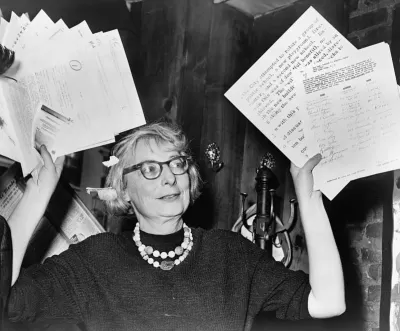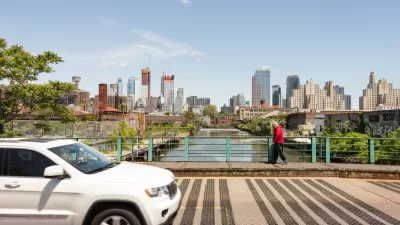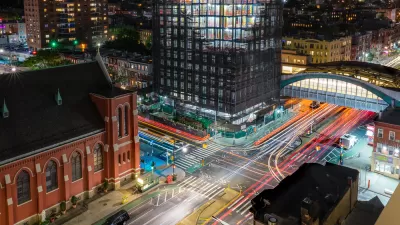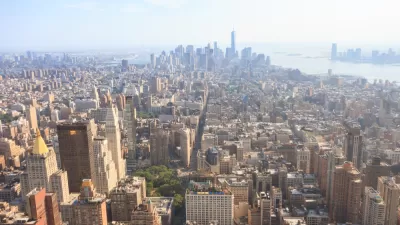New York magazine offers a long reflection on the shifting lessons offered by Jane Jacobs after a year of new books and a re-emergence into the public eye.

According to Justin Davidson, "the paladin of the little people still looms large on the cityscape." Davidson is referring to Jane Jacobs, of course, whose name won't be unfamiliar to any Planetizen reader. Some of the new entries into the Jane Jacobs bibliography, however, might be news. "Robert Kanigel’s new biography, Eyes on the Street (Knopf), and a new collection of her essays, Vital Little Plans (Random House), edited by Samuel Zipp and Nathan Storring, have caused her prestige to spike," explains Davidson.
In a thorough examination of Jacobs's legacy, and its effects for cities, Davidson starts with the traditional narrative of civic empowerment and neighborhood-level advocacy:
Most of us now see the city the way she did, noting incremental changes that alter the topography of our lives: the hardware store that closes, the sandwich shop that opens, the tenement that makes way for a tower. Bike activists, community gardeners, and community organizers put her lessons into practice every day. So do the bureaucrats and planners she abhorred. Her influence is ubiquitous; her ideas have percolated from the radical to the self-evident.
In addition to the local passion she inspired, Jacobs also had an effect on the public opinion with regard to the professional practice of planning. "To her, planning was essentially corrupt, an exercise of thickheaded power by self-important men who blundered expensively into disaster," writes Davidson. "She was not wrong."
Bit now, says Davidson, cities have changed so much and so quickly, that it's time to re-evaluate what Jane would do, and whether, in a new of world of homogenized, corporate affluence and reactionary, NIMBY obstruction, whether "the best way to achieve a Jacobean vision is with un-Jacobean means." That is, argues, Davidson, that now more planning is needed.
After describing Janette Sadik-Khan's book Streetfight: Handbook for an Urban Revolution as "superb" and citing it as an example of the new playbook for planners and urban quality of life, Davidson also leaves the reader with another controversial statement about where Jacobs might feel most at home in 2016.
Jacobs loved cities at a time when that was an unfashionable emotion. Today, a money-fueled urban renaissance bypasses unpromising urban centers and rolls into expensive ones, often invoking her name. But while different camps squabble over her legacy in dense downtowns, a person of her contrarian disposition might find delight in suburbs these days for precisely the same reasons she loved Hudson Street: because big plans don’t take get much traction there, and because that’s where new mixtures of people are fashioning the reality they choose. With sidewalks or without.
FULL STORY: To Honor Jane Jacobs’s Vision, We Need More Planning, Not Less

Study: Maui’s Plan to Convert Vacation Rentals to Long-Term Housing Could Cause Nearly $1 Billion Economic Loss
The plan would reduce visitor accommodation by 25,% resulting in 1,900 jobs lost.

North Texas Transit Leaders Tout Benefits of TOD for Growing Region
At a summit focused on transit-oriented development, policymakers discussed how North Texas’ expanded light rail system can serve as a tool for economic growth.

Using Old Oil and Gas Wells for Green Energy Storage
Penn State researchers have found that repurposing abandoned oil and gas wells for geothermal-assisted compressed-air energy storage can boost efficiency, reduce environmental risks, and support clean energy and job transitions.

Private Donations Propel Early Restoration of Palisades Playground
Los Angeles has secured over $1.3 million in private funding to restore the Pacific Palisades playground months ahead of schedule, creating a modern, accessible space that supports community healing after recent wildfires.

From Blight to Benefit: Early Results From California’s Equitable Cleanup Program
The Equitable Community Revitalization Grant (ECRG) program is reshaping brownfield redevelopment by prioritizing projects in low-income and environmental justice communities, emphasizing equity, transparency, and community benefits.

Planting Relief: Tackling Las Vegas Heat One Tree at a Time
Nevada Plants, a Las Vegas-based nonprofit, is combating the city’s extreme urban heat by giving away trees to residents in underserved neighborhoods, promoting shade, sustainability, and community health.
Urban Design for Planners 1: Software Tools
This six-course series explores essential urban design concepts using open source software and equips planners with the tools they need to participate fully in the urban design process.
Planning for Universal Design
Learn the tools for implementing Universal Design in planning regulations.
Ascent Environmental
Borough of Carlisle
Institute for Housing and Urban Development Studies (IHS)
City of Grandview
Harvard GSD Executive Education
Toledo-Lucas County Plan Commissions
Salt Lake City
NYU Wagner Graduate School of Public Service





























